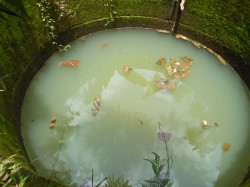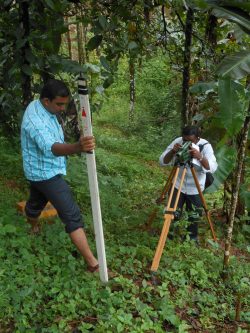
You wake up to the sounds of roosters crowing and cows mewing. You sit up and place your feet on the cool earth. Around you, your 4 small children are still dreaming. Your husband is working and living in another state since there is no viable work for him near home. You may see him a few days each month. The day-to-day responsibilities of taking care of your family rests with you.
It is time to start your day. Breakfast must be prepared, clothes must be washed, and the cow tended to. Before you can begin any of these responsibilities, you need water. There is no faucet you can drowsily make your way to, turn, and voila, have water. You must bundle up and make your way down a steep, often slippery incline, through the forest to the nearest well. During the dry season, the nearest well may be dry. So, you walk further, to another well or to the river, which could take the better part of an hour. After fetching your buckets of water for the day, you must proceed back up the steep inclines, this time juggling the weight of the water jugs.
This day in the life is typical of many of the families in the Wayanad region. Having heard the tribulations concerning water accessibility in the village, Profugo knew it must be a priority. In an executive summary of the Wayanad District conducted by the Indian Council of Social Science Research (ICSSR) between 2005 and 2008, they found that 56.3% of households in the Wayanad district have access to safe drinking water compared to the 87.9% average for the country as a whole. (http://www.icssr.org/Wayanad.pdf)
After becoming aware of the issue by statistics such as the one above and from conducting Household water surveys of 20 or so families in the village, the next step was taking action to remedy the problem. We reached out to a neighboring development organization, the Evangelical Social Action Forum (ESAF), and had two engineers come out to the village to do some surveying of the land. From the survey we had a clearer picture of the logistics of constructing new wells. What materials would be needed, where is the best location for the pvc pipelines, how deep would the wells need to be, what sort of labor is involved, and what are the associated costs? After reviewing the surveys and cost estimates, we developed a plan.
One of our primary objectives was to have those who will benefit from the wells contribute to their construction in some way. This will create a sense of ownership and the hope is the beneficiaries will invest more in the maintenance of the wells and will use them responsibly. People as a whole tend to take that which is given at no cost, for granted. In order to avoid this, the beneficiaries will contribute by way of labor. All the necessary labor to implement the wells will come from those who will be using them.
The executive committee in Prashanthagiri, which will be discussed and signed by all beneficiaries before moving forward, drew up a set of “Rules and Regulations”. It is of utmost importance for the wells to be sustainable. In order for this to happen, it is essential for all to be on the same page and understand their responsibilities and privileges when it comes to the communal usage and maintenance of the wells.
The next step is picking up a shovel and digging. You will all be with us in spirit as we break ground. Stay tuned.


Leave a Reply
You must be logged in to post a comment.